A trip to the Old Patagonia Express
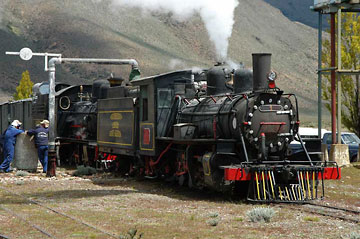 In early November 2004, we booked a
trip to Patagonia, Argentina. The railroad that we wanted to visit
there is known as The Old Patagonia Express. It is located in the area
of Bariloche. In early November 2004, we booked a
trip to Patagonia, Argentina. The railroad that we wanted to visit
there is known as The Old Patagonia Express. It is located in the area
of Bariloche.Trains Unlimited Tours organizes trips for railfans in Latin America. They use mostly chartered trains, which allows to stop trains at interesting locations, and photograph them. For the second part of out Argentina trip we wanted to drive on the Ruta 40 fom El Calafate in the south near the Parque Glaciares north alon the Andes to Comodoro Rivadavia on the Atlantic coast. The picture shows one Baldwin and one Henschel engines taking water at Nahuel Pan station, which is 12 miles uphill from Esquel.. |
|
Buenos Aires Upon arrival in Buenos Aires, we use the Tenda Leon shuttle service to get to our dowtown hotel, from where we start exploring the Retiro area and it's railroad stations. Three
companies operate the three station,
two with broad gauge (the one to the right is all diesel, the line to
the left (looking out from the station building to the line) is
electric), and one is narrow gauge (the Belgrano Norte, meter
gauge). All tracks go in a wide curve
nothwest
towards the neighbourhood of
Palermo, around Palermos vast park areas and then splitting up on a
series of
bridges into three different directions. I liked this area with the
blooming Jacaranda trees and parrakeets,
it is a beautiful neighborhood. |
|
 One nice area to visit is the old port area that is now completely renovated, with the old dock buildings turned into appartments and top end restaurants. We enjoyed a fine dinner in the Cabana Las Lilas - said to be the best steakhouse in th world. We had invited Lisa and Javier, whom we got to know in a travel forum and who had given us valuable information for the Patagonia part of our trip, and spent a truly wonderful evening with them. We do hope we can repeat this - maybe even in some other corner of the world. |
|
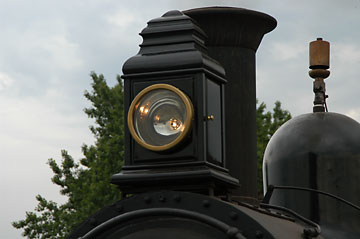 29.10.2005. Lacroze Station, easily reached by the subway line D, is where commuter trains towards Lynch station leave. At Lynch, the Ferroclub Argentino
has
their standard gauge repair
works.
The club has a 2-4-0 fired up for us and switching, along with a
proud collection of passenger cars. |
|
|
|
|

31.10.2005. |
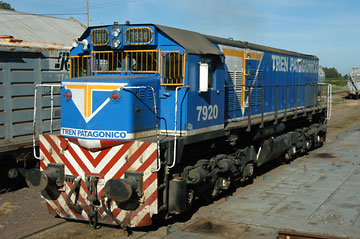
31.10.2005. |
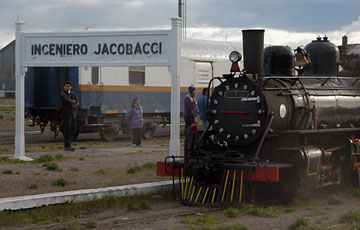
Ingeniero Jacobacchi The trip across the Patagonian plain is of course a bit boring, but finally we approach Jacobacchi in early mornig hours of November 2, 2005. We arrive here at 6:30 am, only two hours late (we expected to arrive a lot later, considering the many delay we'd seen). The narrow gauge
steam train is already waiting for us,
for the first
leg across the hill country southwest to el Maiten. We will have to climb from 876 meters at Jacobacchi to 1214 meters shortly after the station at Ojo de Agua, then after Cerro Mesa to 1208 meters again, before we arrive in El Maiten at 700 meters altitude. |
|
The Trochita 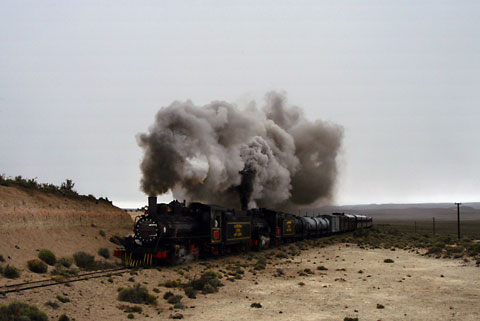
The steam train departs around nine o'cock, after letting the Tren Patagonico depart first. The two trains use a three rail track for the first some 10 kilometers, then the narrow gauge line to El Maiten branches off south while the broad gauge line to Bariloche continues northwest. The rails out of Jacobacchi have not been used for several years. they are rusty and wet as it rains and snows today. |
|
|
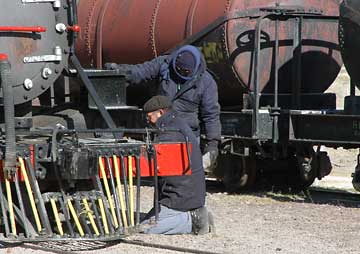 Some
minor
damage
begins to show on one engine, first
repairs are made at Ojo de Agua, finally we can continue our trip. Some
minor
damage
begins to show on one engine, first
repairs are made at Ojo de Agua, finally we can continue our trip.
|
|
Around 9pm we
finally arrive
at the
station of Cerro Mesa, where the engines are taken to the local repair
shop. The crew and local staff start to work on the engines.
Some local ladies take the business opportunity and start to sell very
delicious empanadas and torta frita. Delicious indeed. Repair
work seem to be not too trivial, it lasts and lasts. We get to know
the stars of the Southern Sky very close, one of
the group members happens to be an amateur astronomer. But we do not
hear a triumphant whistle from where the repair shops are. Midnight passes ... |
|
The group leaders try to call our buses to this remote place, which seems to be difficult because of the road condition to up here. But finally the buses get here by about 1:30am. On the way to El
Maiten and then on to our hotel in Esquel, one of the buses has a
problem with the radiator,
he stops every some kilometers, the drivers of the other buses help him
refill fresh water.
We finally arrive at the Tehuelche hotel one night late, at 07:30 am,
just right for
breakfast.
We have been up for more than 30 hour, with not much sleep in
the past three days,
everbody was pretty tired
and eager to get under a shower.
But after a good breakfast we don't go to sleep, we go the train again
immediately ... of course ... |
 One
thing we
noticed was that the railroad does not use the airbrakes on their cars.
The air hoses remain uncoupled, the engineer brakes the train by
applying the reverser
and open the steam throttle. This method appears dangerous and can be
ineffective, too.
We tried to stop the train for photos at a certain spot, but ran past
for one full kilometer.
And because the engines have only one sand dome with a tube down to the
first driving wheel,
they have no sand when going backward.
So the train could not back up to the photo spot, and we had to look
for another one. One
thing we
noticed was that the railroad does not use the airbrakes on their cars.
The air hoses remain uncoupled, the engineer brakes the train by
applying the reverser
and open the steam throttle. This method appears dangerous and can be
ineffective, too.
We tried to stop the train for photos at a certain spot, but ran past
for one full kilometer.
And because the engines have only one sand dome with a tube down to the
first driving wheel,
they have no sand when going backward.
So the train could not back up to the photo spot, and we had to look
for another one.The picture to the left shows one of the Baldwin engine beeing serviced after a trip at the El Maiten shops. The rails in the shop are elevate about one meter for easy inspection of the running gear. |
|
|
|
6.9.2004, Maiten to
Lepa. |
|
7.9.2004 Esquel - El Bolson - Bariloche. Late morning start on the bus towards Bariloche. Part of the group takes the narrow gauge train back to Jaccobachi and the broad gauge tren Patagonico from there to Bariloche. With the experience of the first day we decide we do not go with them but take a direct bus to Bariloche. On the way, we have time to visit the town of El Bolson, kown for it's old-time hippie community and market. We were not very impressed ... |
 Bariloche Bariloche 8.11.2004 - Walking on the Circuito Chico. Bariloche is the tourist central of northern Patagonia. has lots of chocolate shops to offer, and a lot of fine restaurants - the town itself has little to offer. The scenery however is fantastic, so if you can, reserve enought time to explore the area. We decide to fly back to BA instead of using the tain, this gives us two extra days here. We try to make a boat trip but are to late with our decision, all boats are sold out. We take a taxi to the Puerto Panuelo 25 km away, but cannot get a ride on a boat there either. We decide to go for a leisurely lunch at the splendid Llao Llao hotel (that is one place for your stay, for sure), and then start to walk back as far as we get, along the main road, and finally end up taking a Number 20 bus to return to Bariloche. We join our travel group for a farewell dinner at a local "parilla". The food is very good, but the wine that the restaurant owner recommends is truly fantastic, (a Lagarde Malbec 2000, see www.lagarde.com.ar). |
|
The second part of
our trip is a private tour, without
tour
guides. |
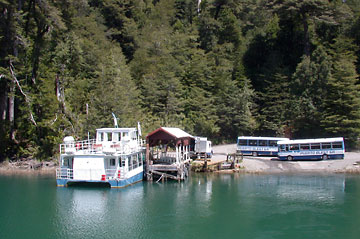 9.11.2004 -
Boat trip on Lake Nahuel
Huapi. 9.11.2004 -
Boat trip on Lake Nahuel
Huapi. Today we are more lucky, we manage to reserve a full day boat trip to the Chilean border with the help of a local travel agency. The catamaran type boat leaves Puerto Panuelo in Llao Llao at 10:45 for the one hour trip to Puerto Blest at the end of the western arm of the lake Nahuel Huapi. We can do the trip in beautiful sunlight, seagulls follow the boat, people feed them of course as the do everywhere. We transfer to three buses for the short trip to Puerto Alegre on the shore of Lago Frias. The short trip across this little lake takes only 15 minutes. We arrive at a little port, where a small kiosque sells hot chocolate as their specialty, enriched with a shot of cognac. Here we are very close to the Chilean border, and are not allowed to walk out of the port area. On the way back we stop at the Puerto Blest Hotel for a quick lunch, before we start for a short walk uphill to Lago Cantaros. All of a sudden, we get strong gusts of wind, followed by light rain. It is amazing to see how fast the weather changes here. 16:45 we go back the same route, and end this beautiful day with the usual glass of Sauvignon blanc at the hotel. |
|
|
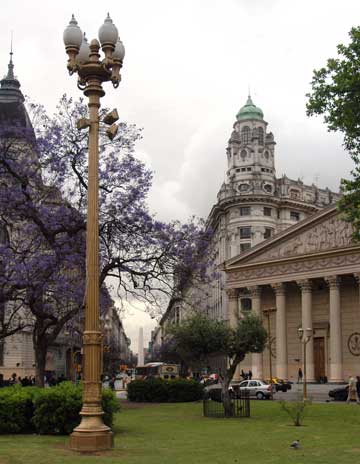 10.11.2004
- Flight Bariloche to Buenos Aires 10.11.2004
- Flight Bariloche to Buenos Aires We manage to get a flight out of Bariloche for the 10th instead of returning by train. This gives us one day more in Bariloche and one day more in Bueno aires. All direct flights to El Calafate are full, so the detour via BA cannot be avoided. But at least the 48 hour train trip with no washing facilities can be avoided. Our tour guides are not particularly happy about this decision, but at least a dozen people take the same shortcut back to BA. 11.11.2004 - Buenos
Aires |
|
A smooth flight,
followed by a transfer to the the Estancia
Alice,
20 km out of town. This estancia runs a farm type hotel at their former
workshop - called El Galpon. I take a long walk around the Laguna de
Pajares to
see some of the
birds and sheep that live on the lake. Its a cloudy afternoon, and it
starts to rain soon.
I am proud to be able to share this picture of a Ibis flying into a
rainy sky with you - i personally have never ever seen one before. A very impressive
live sheep
shearing demonstration and and a fine parilla dinner top this
day. We are very
impressed by the cordial reception by just
everybody in this
estancia. If you have a choice - plan to stay at this estancia. |
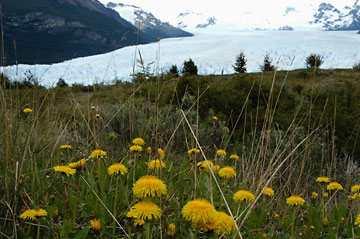
13.11,2004 El
Calafate, Perito Moreno Glacier The glacier is very impressive, and the sight of dandelion flowers and a glacier is not too common, at least i don't know this from here in Switzerland. We have to change
hotels today - El Calafate really seems to be fully booked - our new
hotel is out of town on the Laguna Nimez. This place is all
new, and is in an absolutely wonderful nature park area. |
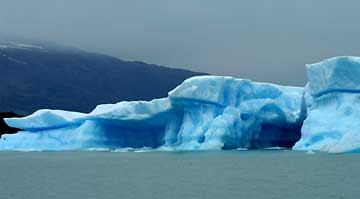 14.11,2004
El Calafate, Uppsala Glacier Cruise 14.11,2004
El Calafate, Uppsala Glacier Cruise Another partly rainy day for our drive to Puerto Banderas. But even for the early season the boats are full. We cruise to the spectacular Spegazzini glacier, then on to Onelli landing for a fine lunch at the remote restaurant there. There is enough time for a leisurely walk throug the untouched wood up to a lake where another glacier ends, and sends it's icebergs into the water. The trees in this wood are most impressive, the virtually make us feel the rough conditions out here. The cruise continues along icebergs of unreal tones of blue to the majestic Uppsala glacier. |
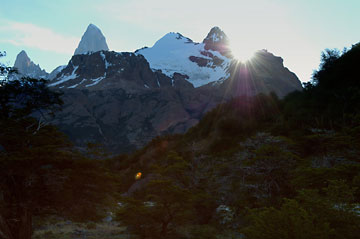
15.11,2004 El
Calafate to El Chalten |
|
On the way we encounter a local gaucho, who transports supplies to the base camp near the Laguna Torre. |
|
17.11.2004:
Drive from El
Chalten to the Perito Moreno National Park
Thank you, Edoardo,
and 'What a day' ... |
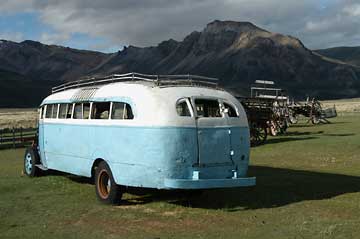 18.11.2004
PN
Perito Moreno 18.11.2004
PN
Perito MorenoWe stay for two
nights at the estancia and spend a
wonderful time driving and walking
around the park area, looking for Guanakos, foxes, rabbits, flamingos,
condores, other birds and other
wild animals. The park really is a lonely area, we did not meet or see
anybody else in the whole park. The condors however
seem to
spend their time somewhere else, although we obbserve their nesting
cliff - condorera - very closely, we can't see any - but we have very
windy conditions, maybe that has chased them away. The estancia
has a museum type collection of
historic machines and tools, fom water pump to radio transmitters
to wagons and this vintage bus here - El
Cordillero. |
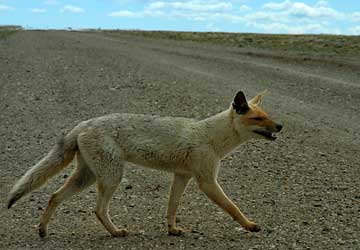 19.11.2004:
Drive from PN
Perito Moreno to Lago Posadas 19.11.2004:
Drive from PN
Perito Moreno to Lago Posadas With Edoardos help
we pour the
contents of our two bidones into the tank and leave very early.
No road problems this time, we carefully avoid all mud holes
longer than
two meters.
We're lucky to meet this little fellow here along the road, a curious
young fox. Short stop in Bajo
Caracoles to fuel up on gas,
then we east to visit the Cueva de las Manos. After havinf driven the
distance listed in our guide, there is no hint to the existence of
caves here. We are on the wrong road, but the scenery is spectacular. We decide to visit the Cuevas later on our way north, and go back west towards the Lago Posadas and Lago Pueyderron. |
|
The estancia is
located on the southern end of a narrow
isthmus betweeh the two lakes, whose distinctedly different colour
really amaze - from whatever direction you look, one lake is deep blue,
the other
is turquoise. We spend the time driving and walking up a valley towards where we've just come from - the Perito Moreno national park. It was a long drive, but a hike would only last two days from PN Perito Moreno to Lake Puederron. This would be a wonderful rout fro trekking. The road ends somewhere up in the valley, and we finally cannot conntinue with our car, so we hike around for some hours and then return to the estancia - we absolutelly do not want to miss the dinner here. Thanks again Dona Ana! |
|
The shortcut road to Los Antiguos seems to be closed due
to the heavy rain during the past days. With the road experience of the PN Perito Moreno we
believe that we might get ourselves in trouble if we tried to cross the
mountain there on a road nobody ever uses ... and opt for the detour
route east to the Ruta 40 then north to Perito Moreno and finally west
again along the Lago Buenos Aires to the village of Los Antiguos. |
|
The beauty here in this little town clearly is the lake. We do endless walks along the lake shore and just enjoy the scenery. Our hotel wa initially built by the state for sports training camps, and seems to be the only 'real' hotel in town. Magnificent scenery here, but otherwise not much to see or do ... |
|
24.11.2004 Los Antiguos to Comodoro Rivadavia A smooth drive on the paved highway out to the Atlantic
coast, along many oil drilling facilities, and we finally arrive early
in Comodoro Rivadavia. We explore the former railroad station and steam
engine display, and then enjoy a fine farewell dinner. Tomorrow will be
two days of flying home and mediocre quality airline food. |
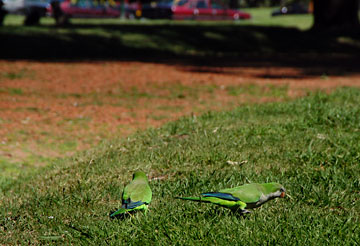
 Here's a
picture
showing the bridges where the lines split. A train of the
Metropolitano line passes the bridge.
Here's a
picture
showing the bridges where the lines split. A train of the
Metropolitano line passes the bridge.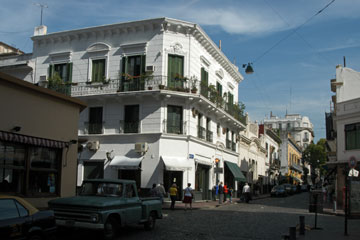 The Boca neighbourhood is one
other
very nice part of the city to visit. We just had not enough time to
explore it fully, but what we have seen was quite impressive. It
somehow felt like beeing in a town in France - we just liked to walk
around there.
The Boca neighbourhood is one
other
very nice part of the city to visit. We just had not enough time to
explore it fully, but what we have seen was quite impressive. It
somehow felt like beeing in a town in France - we just liked to walk
around there.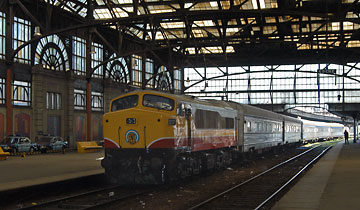 30.10.2005.
30.10.2005.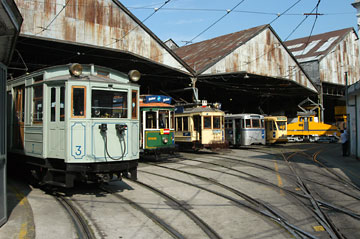 In
the afternoon, the wheater cleared
up
as we visited the Tramway
museum at the Metrovias repair
shops,
many beautifully restored tramway vehicles, were shown in operation,
running around a 2 km loop.
In
the afternoon, the wheater cleared
up
as we visited the Tramway
museum at the Metrovias repair
shops,
many beautifully restored tramway vehicles, were shown in operation,
running around a 2 km loop.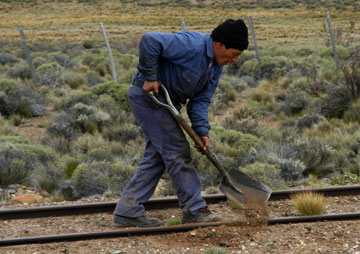
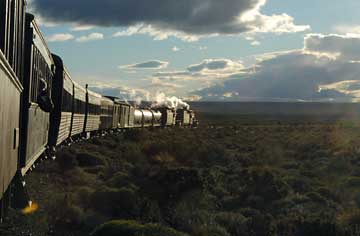
 We
wait for a long time. We are very happy to find enough wood to heat
the
stoves in each car, as it gets dark it gets cold, we are reminded that
we are in a mountain area. The railroaders had - knowingly - stocked up
on wood.
We
wait for a long time. We are very happy to find enough wood to heat
the
stoves in each car, as it gets dark it gets cold, we are reminded that
we are in a mountain area. The railroaders had - knowingly - stocked up
on wood.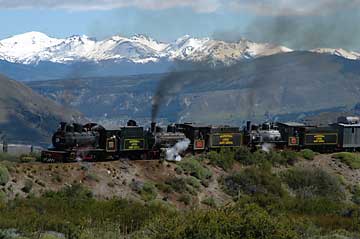 5.9.2004,
Esquel to
El Maiten.
A truly wonderful day awaits us for the run from Esquel towards El
Maiten.
For some reason we cannot have the formerly promised freight train,
but have the two Baldwins and the Henschel for a triple header out of
Esqquel up to Nahuel Pan.
Four box cars are added to make a mixed consist.
In Nahuel Pan the Henschel is taken off the train and returns to Esquel
with the box cars to service the local train. We stop for an hour at
Nahuel Pan,
to water the engines, to havae lunch an make some photos of a track
gang and their speeder.
We leisurely continue towards Lepa station, and make some photo stops
here and there.
The cirrus cloud cover that gave us grief on the past days does not
show up today,
a deep blue ssky with many small cumulus clouds sets the background
today, its spring.
5.9.2004,
Esquel to
El Maiten.
A truly wonderful day awaits us for the run from Esquel towards El
Maiten.
For some reason we cannot have the formerly promised freight train,
but have the two Baldwins and the Henschel for a triple header out of
Esqquel up to Nahuel Pan.
Four box cars are added to make a mixed consist.
In Nahuel Pan the Henschel is taken off the train and returns to Esquel
with the box cars to service the local train. We stop for an hour at
Nahuel Pan,
to water the engines, to havae lunch an make some photos of a track
gang and their speeder.
We leisurely continue towards Lepa station, and make some photo stops
here and there.
The cirrus cloud cover that gave us grief on the past days does not
show up today,
a deep blue ssky with many small cumulus clouds sets the background
today, its spring. 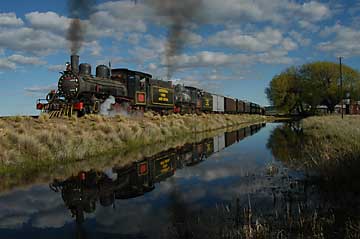 At
Lepa we make the last photos of our train for today. a beautiful
reflection in a creek
and some green trees at the station house make a very nice scenery for
the train.
We take the opportunity to return early by bus from Lepa. and let the
train continue
its trip to El Maiten without us.
At
Lepa we make the last photos of our train for today. a beautiful
reflection in a creek
and some green trees at the station house make a very nice scenery for
the train.
We take the opportunity to return early by bus from Lepa. and let the
train continue
its trip to El Maiten without us.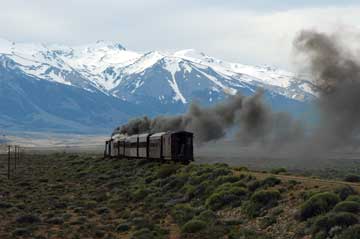 The
railroad has three engines in operable condition. and a fourth one
is currently being rebuilt at the El Maiten shops.
This seems just not enough for the planned operations for this railroad
(the full length of the line is 420 km).
It doesn't even seem enough for our planned trips , one
engine is assigned to the
daily tourist train between Esquel and Nahuel Pan - the first station
on
the way to El Maiten - and
therefore stays in Esquel most of the time.
The
railroad has three engines in operable condition. and a fourth one
is currently being rebuilt at the El Maiten shops.
This seems just not enough for the planned operations for this railroad
(the full length of the line is 420 km).
It doesn't even seem enough for our planned trips , one
engine is assigned to the
daily tourist train between Esquel and Nahuel Pan - the first station
on
the way to El Maiten - and
therefore stays in Esquel most of the time. This
more or less concludes the first
part of our argentina
trip,
where we could rely on our tour guides. From now on we travel on own. A
last very charming sight were
the baby St. Bernhard dogs that some locals show to tourists on
Bariloche's main
plaza - for money, but still charming.
This
more or less concludes the first
part of our argentina
trip,
where we could rely on our tour guides. From now on we travel on own. A
last very charming sight were
the baby St. Bernhard dogs that some locals show to tourists on
Bariloche's main
plaza - for money, but still charming.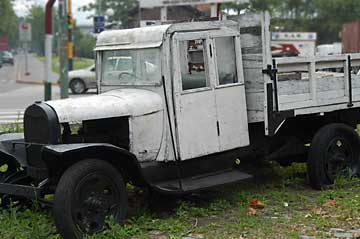
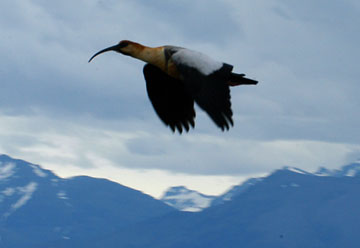 12.11.2004 - Flight from B.A. to El
Calafate
12.11.2004 - Flight from B.A. to El
Calafate  16.11.2004 El
Chalten
16.11.2004 El
Chalten Farther on the
way i
manage to shoot some close-ups of an armadillo.
Farther on the
way i
manage to shoot some close-ups of an armadillo. 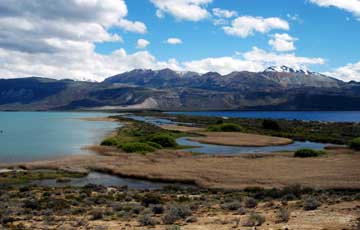 20.11.2004,
Estancia Lagos del Lagos del Furioso (Lago Pueyderron). The
Furioso river gives the estancia it's name. We are welcomed by Dona Ana
on the finest estancia on our trip, and enjoyed all of our days
there.The estancia cultivates a very fine cuisine, and has an excellent
wine cellar. We got to know some of the best Argentina wines right
here. This truly was our favourite place in whole Patagonia.
20.11.2004,
Estancia Lagos del Lagos del Furioso (Lago Pueyderron). The
Furioso river gives the estancia it's name. We are welcomed by Dona Ana
on the finest estancia on our trip, and enjoyed all of our days
there.The estancia cultivates a very fine cuisine, and has an excellent
wine cellar. We got to know some of the best Argentina wines right
here. This truly was our favourite place in whole Patagonia.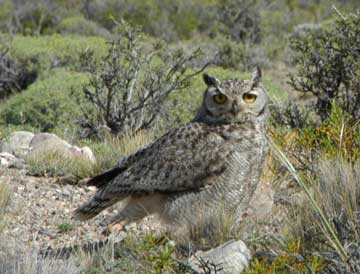 21.11.2004 Lago
Posadas to Los Antiguos
21.11.2004 Lago
Posadas to Los Antiguos  22.11.2004
Los Antiguos
22.11.2004
Los Antiguos